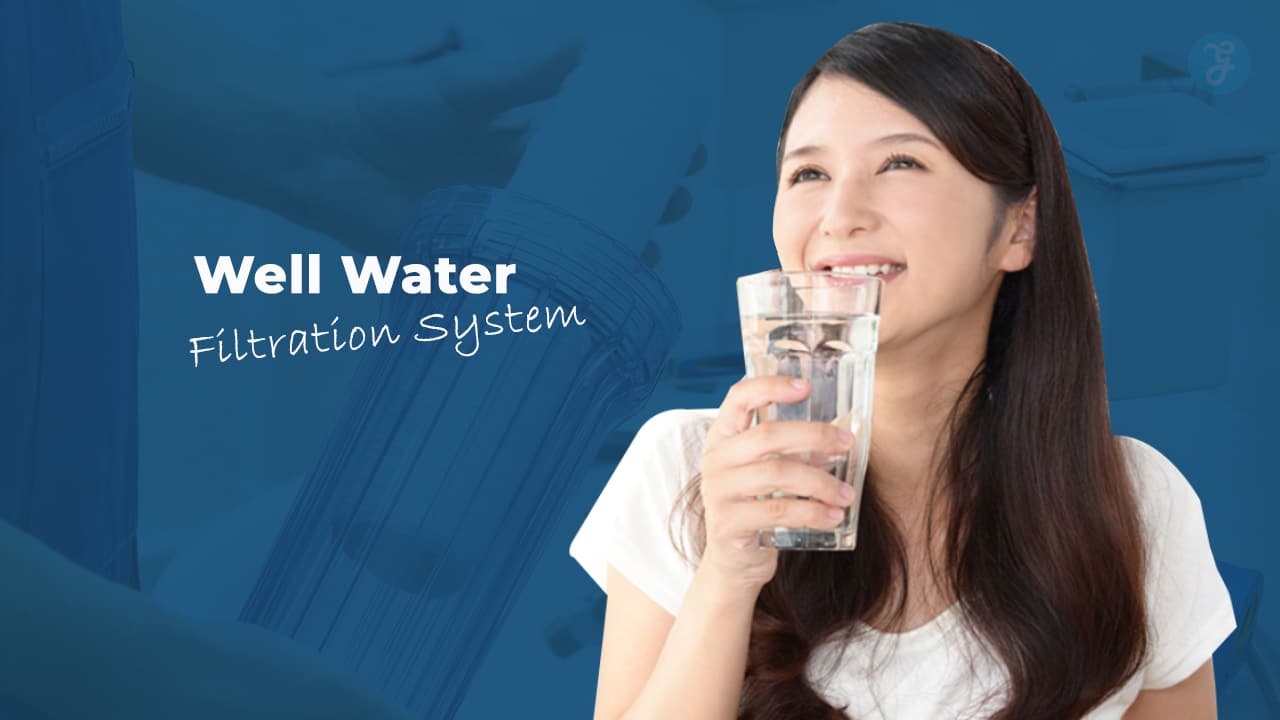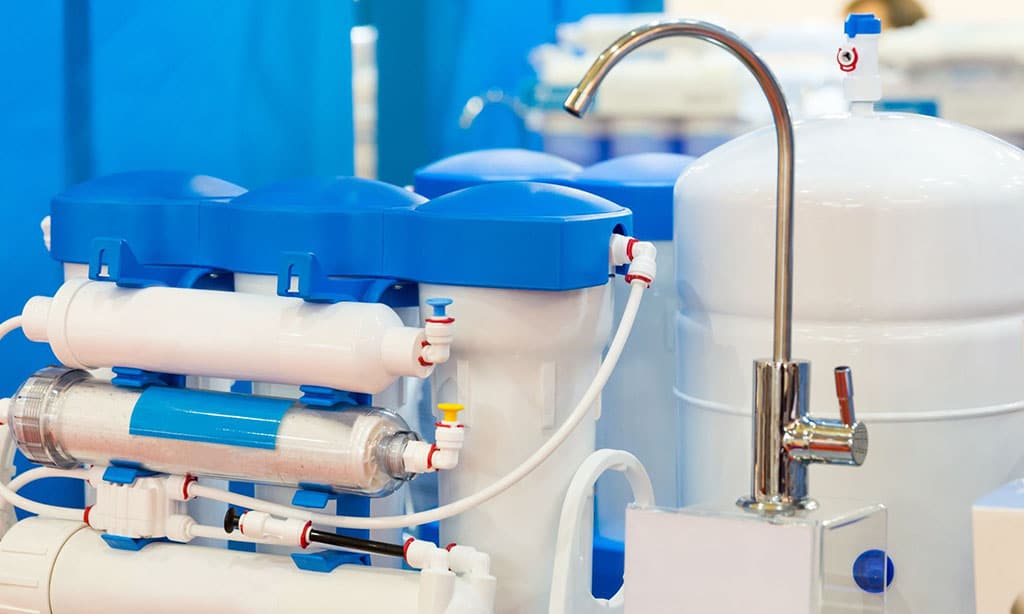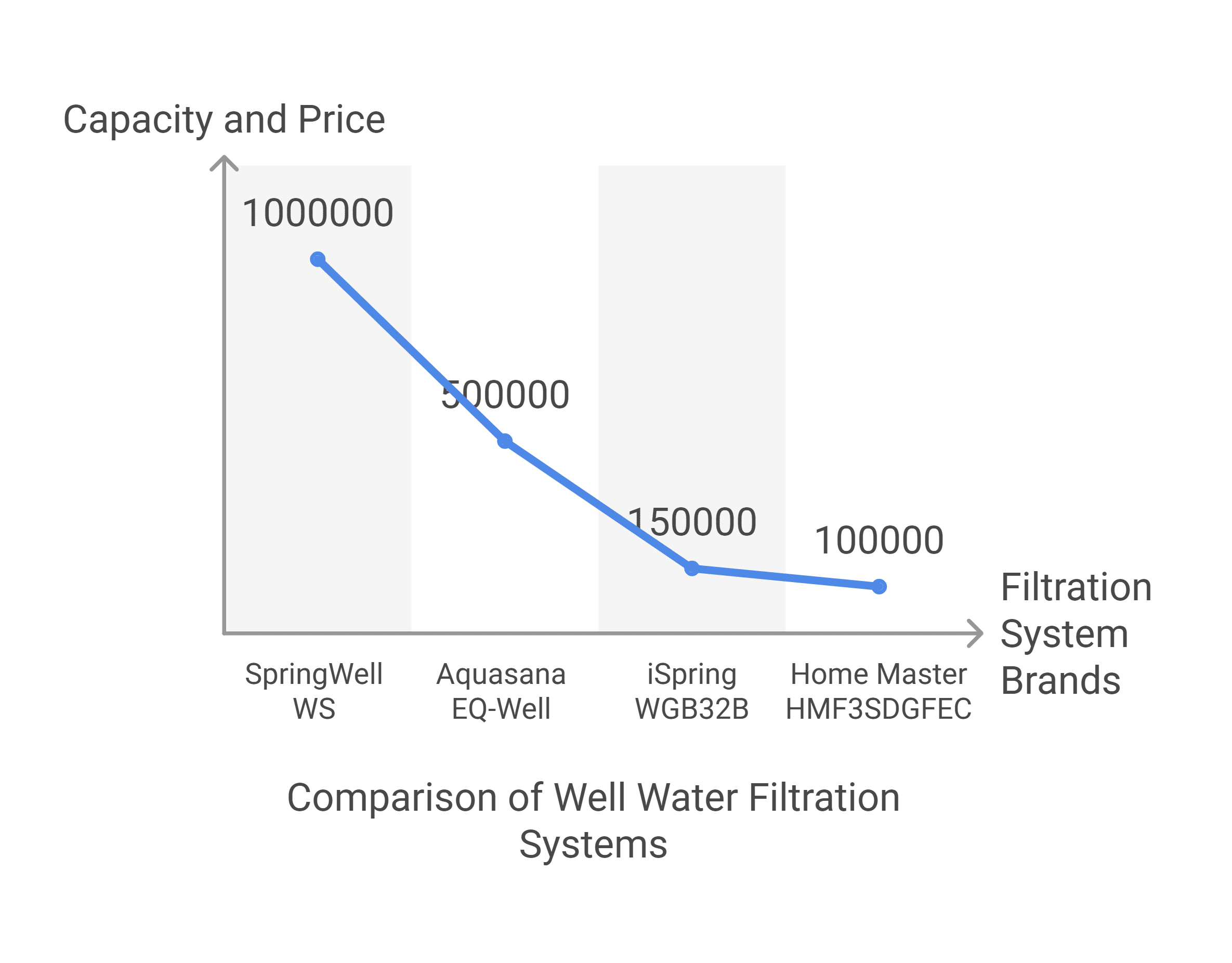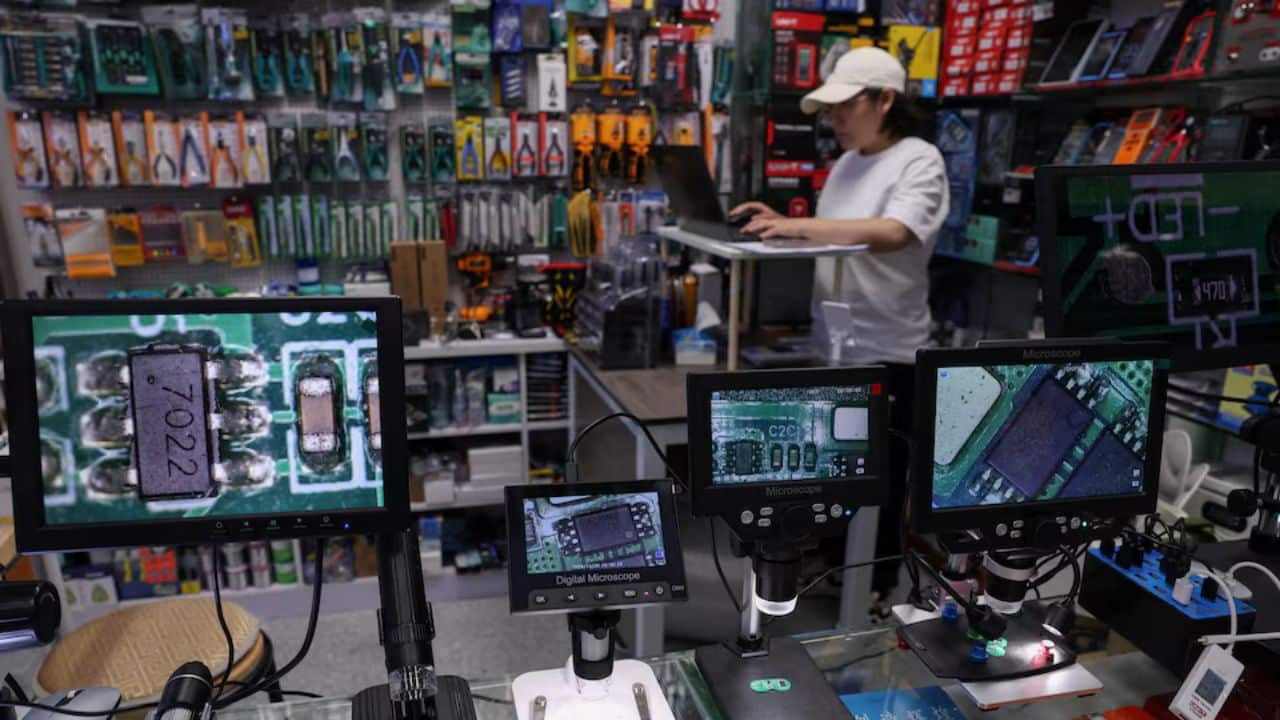Ever turned on the faucet to find water that smells more like a failed science experiment than something you’d want to drink? Yeah, I know the feeling. It’s a real headache for those of us relying on well water.
Our water carries stuff we can’t see but definitely would rather not gulp down. I discovered that whole house water filtration systems are game changers in this battle for clean drinking water.
In this blog, I dive into why our wells might be giving us grief, from sediment to invisible bacteria. I’ll explore various well water filtration systems designed to tackle these problems head-on. Whether it’s large systems cleaning every drop in your home or nifty gadgets zapping germs away, there’s a solution here for everyone.
Stick around; your sense of smell will thank you later!
Common Issues with Well Water
Let’s chat about what can go wrong with well water. You might find stuff like dirt or tiny rocks, and even things that make the water hard. Also, tiny critters you can’t see without a microscope could be swimming in there.
And let’s not forget about bad stuff like lead or other nasty bits that shouldn’t be in your drinking water.
Sediment and debris
Sediment clogs well pumps and messes up water systems. It also blocks pipes. I see cloudy water or sand in my glass? That’s a sign of sediment. Experts say to test well water every three years, or sooner if things look off.
The trouble often starts with the pump or where it sits in the well. Hard water minerals come next on the list for me to tackle.
Hard water minerals
So, I learned that hard water is a real troublemaker. It’s loaded with too much magnesium and calcium. These minerals might sound healthy, but not when they’re in your water in high amounts.
About 85% of folks across the U.S. deal with this issue. It’s a big deal because over time, these minerals build up and can wreck plumbing, appliances, and even make clothes feel rough after washing.
I noticed signs around my house like dry skin after showers, lower water pressure than usual, and a strange buildup on shower heads and faucets. That clued me in that I’m dealing with hard water.
Turns out, things like whole house filtration systems or water softeners are solutions to tackle these pesky minerals head-on.
Bacteria and microorganisms
Moving on from the gritty business of dealing with hard water minerals, let’s talk about something even smaller but just as pesky: bacteria and microorganisms in well water. I’ve learned that common culprits like total coliform, fecal coliform, E.
coli, and Giardia love to make a cozy home in our wells. These tiny invaders find their way into our water supply through runoff, leaking sewers, or after a flood.
I make it a point to test my well water every year because these microbes can cause serious stomach troubles like diarrhea, vomiting, and cramps. And trust me, nobody wants that kind of party crasher.
The idea is not just to have clean-looking water but truly purified water free from invisible threats lurking around waiting to spoil more than just your day.
Heavy metals and contaminants
Heavy metals like arsenic, chromium, and thallium often find their way into well water. They sneak in both from natural earth materials and human activities. It’s a sneaky problem because you can’t see or smell these contaminants.
About 97.87% of the risk for cancer in certain areas comes from arsenic alone. I learned that drinking water with too much of these metals over time is bad news for health.
To keep my family safe, I looked into water filters that could tackle these tough guys head-on. The right filtration system makes all the difference, pulling out harmful substances before they reach our tap.
It’s not just about making the water taste better; it’s about keeping those invisible threats away from our glasses and bodies.
Types of Well Water Filtration Systems
To clean up your well water, there are numerous and diverse solutions. Envision a variety of filters and purifiers equipped to handle everything from coarse debris to invisible germs floating in your glass.
Explore the sector of comprehensive house cleaners, reverse osmosis machines, UV light annihilators, spin-down particle trappers, carbon absorbers, and descaling wizards. It’s akin to choosing your preferred superhero squad against water adversaries! Intrigued? Continue to discover each champion’s unique abilities.
Whole house water filtration systems
I’ve got a whole house water filtration system and let me tell you, it’s a game-changer. With this setup, every drop of water that comes through my pipes is clean. We’re talking about getting rid of things like chlorine, sediment, and even those pesky hard minerals that make water taste funny.
Not to mention, these systems protect the plumbing. It’s like having bottled water on tap all the time.
Take the SpringWell Whole House System for example. This powerhouse can handle 1,000,000 gallons over its lifetime and only costs $1,020. Then there’s the Aquasana Rhino system which boasts a lifespan of either 1 million gallons or 10 years for $1,998.
And if I want something extra robust against bacteria and microorganisms? The Rhino Well Water with UV has got me covered for 5 years or 500,000 gallons at $4,892. Each sip feels safer knowing these filters are in place.
Reverse osmosis systems
So, let’s talk about reverse osmosis systems for treating well water. They work like magic to pull out up to 99% of bad stuff, including lead, fluoride, and arsenic. Think of it as a super-fine sieve that only lets clean water through while trapping the nasties.
I heard the Moen system costs about $399.00, not too shabby for peace of mind, right? And those membranes in the system? They need a swap every two years to keep doing their job.
The US Water Systems Defender caught my eye because it’s a champ against high salt and fluoride levels – something you don’t want in your morning coffee. Using these systems feels like giving your water a superhero cape; suddenly, it’s safe from almost all villains lurking unseen.
Plus, fitting one under my sink made me feel like I had my own little water treatment plant at home. Pretty cool way to turn tap into top-notch H2O!
UV water purification systems
UV water purification systems use ultraviolet light to kill germs in well water. They can eliminate 99.9% of bacteria and pathogens. This means cleaner, safer water for drinking and cooking.
I find it comforting knowing that these systems provide protection against boil water alerts.
The SpringWell UVC5-15 model has a flow rate of 15 gallons per minute, which is quite impressive! However, it’s important to replace the UV lamp every year to keep the system running well.
These systems are eco-friendly and help improve overall water quality by removing harmful contaminants without using chemicals.
Spin-down sediment filters
Moving on from UV water purification systems, I find spin-down sediment filters quite interesting. These devices help trap dirt and debris in well water. They use a simple design that allows sediments to settle at the bottom of a clear container.
I love that they have a 50-micron screen. This means they can remove up to 99% of sediments, dirt, and rust. Plus, their maximum flow rate is impressive at 25 gallons per minute (GPM).
Cleaning is easy; just flush out the collected junk when it gets full! This keeps my water clean without much hassle.
Activated carbon filters
Spin-down sediment filters help catch larger particles in well water. After that, I turn to activated carbon filters. These filters work wonders by removing chlorine and other harmful pollutants from my water.
The process involves using tiny granules of carbon that trap impurities. They also improve the taste and smell, making my drinking experience much better.
Cartridge-based carbon filter packages start at just $225.95, offering a budget-friendly option for cleaner water. ClearPlus backwashable catalytic carbon filters are more advanced but come with a price tag starting at $824.00.
For me, pairing these filters with UV sterilizers is wise for microbiological safety. Activated carbon filters indeed play a significant role in enhancing overall water quality while protecting plumbing systems too!
Anti-scale water softeners
Moving from activated carbon filters, anti-scale water softeners play a crucial role in protecting my home’s plumbing. The WDS150K model, for instance, uses a special scale inhibitor.
It operates without salt, making it eco-friendly. This helps to prevent scale buildup and corrosion in pipes and appliances.
I enjoy softer water that feels great on my skin and hair. Plus, using this system means less maintenance for my dishwasher and water heater. I’ve noticed fewer issues with clogs too! Overall, investing in an anti-scale water softener has truly improved my daily life at home.
Key Benefits of Well Water Filtration Systems
Well water filtration systems can change your life. They make your water cleaner and tastier, while also keeping harmful stuff away from your home. You’ll notice softer skin and shinier hair after a shower.
Plus, these systems help keep your plumbing and appliances in good shape. Who knew clean water could be this much fun?
Removal of harmful contaminants
I want safe drinking water. Filtration systems help remove harmful contaminants from well water. They tackle tough issues like bacteria and heavy metals. This means no more worry about arsenic or excessive nitrates in my glass of water.
These systems neutralize pH levels too, which is a bonus. Clean water protects home fixtures from damage over time. I see how valuable this is for plumbing protection and keeping appliances running smoothly.
Knowing that my family drinks safe, clean water brings peace of mind every day!
Improved water taste and odor
Clean water should taste fresh and smell good. With a well water filtration system, I noticed a big change in both. Carbon filters work wonders for removing chlorine, sediment, and organic compounds that can spoil the flavor.
They make my water taste pure, not like it came from a rusty pipe.
Well water often lacks added chemicals like chlorine. This makes it naturally cleaner. But sometimes, there are still odors or tastes from minerals and bacteria. A solid filtration system helps eliminate these issues.
The result? Softer skin after my shower, and refreshing drinks straight from the tap! That’s the boost I’m looking for in my daily routine!
Protection for appliances and plumbing
Enhanced water taste and odor leads to another key benefit: protection for appliances and plumbing. Unfiltered well water can clog pipes or cause corrosion. It creates scale buildup in appliances like dishwashers, washing machines, and water heaters.
This damage can lead to high repair costs over time.
Using a whole house filtration system helps keep my plumbing safe. It filters out sediment and heavy metals that might harm these systems. Investing in good filtration protects my home and extends the lifespan of appliances.
I save money by avoiding costly repairs later on!
Softer skin and healthier hair
Hard water can really mess with my skin and hair. It often leads to irritation and redness. Some days, I even get eczema flare-ups. My soaps and shampoos don’t help much against this problem either.
They just can’t counteract the effects of hard water.
By using a well water filtration system, I noticed softer skin. Filtering out those hard minerals makes a difference. Skin feels smoother, and it’s easier to keep it hydrated. Hair also improves; it looks shinier and healthier.
These benefits make daily routines more enjoyable for me!
Eco-friendly water solutions
Well water filtration systems are beneficial for the environment. They help conserve local water resources. With these systems, I can drink clean water without creating plastic waste from bottled drinks.
This results in fewer bottles in landfills and less stress on our planet.
These systems also use less energy than large treatment plants. Reduced energy means a smaller carbon footprint for me and my home. Using efficient filters not just improves my water quality but also helps keep the earth healthy.
It’s a win-win situation! Now, let’s explore how these well water filtration systems operate.
How Well Water Filtration Systems Work
Well water filtration systems work in stages. First, they remove large particles like dirt and sand using filters. Then, smaller contaminants are filtered out next. Some systems soften the water by reducing minerals that cause hardness.
Others use UV light to kill germs and bacteria, ensuring safe drinking water for my family.
Pre-filtration stage
The pre-filtration stage is an important first step in cleaning well water. I use a sediment filter to remove larger particles like dust, dirt, and rust. This helps keep my water clean right from the start.
Replacing the pre-filter every 2-3 months is key for good performance. It captures big debris before it moves into other systems. By removing these larger particulates early on, I protect my whole house filtration system and tap into better water quality overall.
It’s simple yet effective!
Filtration for contaminants
Filtration systems remove harmful contaminants from well water. Sediment filters catch dirt and debris, protecting my plumbing. UV disinfection systems kill bacteria and viruses, ensuring the water is safe to drink.
Activated carbon filters reduce chlorine taste and odors effectively. For heavy metals like iron or lead, reverse osmosis works best. These tools work together to improve overall water quality while keeping my home healthy.
Softening and conditioning
Softening and conditioning improve the quality of well water. I like how FutureSoft Salt-Free Conditioner uses Template Assisted Crystallization (TAC) technology. It turns hard minerals into crystals that don’t stick to surfaces.
This helps with stains from iron, manganese, and sulfur. Plus, it reduces bad smells from hydrogen sulfide.
Using a water softener makes my skin feel softer after a shower, and my hair looks healthier too. The right system can change the entire experience of using well water at home. Next up is learning about UV purification processes for safe drinking water!
UV purification process
UV purification uses light to make well water safer. A UV system shines ultraviolet rays on flowing water. These rays kill 99.99% of viruses, bacteria, and other unwanted microbes.
It works fast and does not need chemicals at all.
Before the UV process kicks in, I like to install a sediment filter first. This step helps clear out dirt that could block UV rays. Without this filter, the water might turn cloudy or turbid, reducing the power of the UV light.
Having both systems together offers a strong line of defense for well water quality improvement and keeps my plumbing protected from germs and harmful contaminants.
Choosing the Right Well Water Filtration System
Choosing the right well water filtration system can feel like a tricky puzzle. Start by checking the quality of your water. Test it for heavy metals, bacteria, and other nasty stuff.
Then, think about how much water you use daily. This will help you pick the right size filter for your home. Don’t forget to consider how often you’ll need to change filters too; keeping up with maintenance is key! If you’re curious about what else to look out for, keep reading!
Assessing your water quality
Assessing water quality is a must. I learned that testing can reveal what’s in my well water. A professional water test helps identify harmful impurities like sediment, iron, and bacteria.
Knowing the specific contaminants makes it easier to choose the right filtration system for my needs.
Key things to look out for include sulfur and manganese, which can affect taste and smell. Agricultural contaminants may also be present. Regular tests help me stay informed about changes in my well water quality over time.
This knowledge guides decisions about improving overall safety and enjoyment of drinking water at home.
Determining system capacity
After I assess my water quality, the next step is determining system capacity. This tells me how much water my filtration system can handle before it needs maintenance. A higher capacity means less frequent changes, which saves time and effort.
I need to think about my household’s water demands. For example, if I use a lot of water each day, I should choose a system with a good flow rate measured in gallons per minute (GPM).
It’s smart to pick something that fits my everyday needs so that I get clean well water without hassle.
Considering maintenance requirements
Moving from system capacity, maintenance plays a vital role in your well water filtration system. I’ve learned that sediment filters need regular changes every 3 to 6 months. Overlooking this can lead to clogs and poor water quality.
Carbon filters also require attention, though they last longer than sediment ones. Periodic upkeep is still important to maintain their effectiveness.
I find that consulting with professionals helps me choose the right maintenance plan for my needs. They offer insights on what works best based on my water quality and usage patterns.
A little planning goes a long way in keeping the whole house filtration systems running smoothly!
Evaluating installation needs
Installing a well water filtration system can be tricky. I assess what my home needs before diving in. Space is key; some systems need more room than others. I check if there’s enough space for a whole house water filtration system or point-of-use setups.
Next, the plumbing matters too. My pipes should handle new equipment well without leaks. Water pressure and flow rate are crucial factors as well. If those levels are off, it could cause issues later on.
Having these details clear helps me avoid headaches down the road!
Popular Well Water Filtration System Brands
When I think about well water filtration systems, some brands stand out. SpringWell and Aquasana both offer great options that many people trust for clean water.
SpringWell WS
The SpringWell WS Well Water System is a significant improvement. It reduces iron, manganese, and hydrogen sulfide in my water. With a capacity of 1,000,000 gallons, it lasts a long time before needing replacement.
Plus, its flow rate ranges between 12-20 GPM. That means strong water pressure for daily use.
I’ve seen firsthand how this system enhances overall water quality. Well water often has hidden contaminants like heavy metals that can affect taste and health. The filtration process removes these impurities and also makes the water safer to drink and better for cooking.
Investing in the SpringWell WS has really paid off!
Aquasana EQ-Well
Moving on from SpringWell WS, let’s explore the Aquasana EQ-Well. This filtration system stands out for its ability to handle tough well water issues. It removes heavy metals, sediment, and other harmful water contaminants effectively.
I like how it combines multiple stages of filtration to improve overall water quality.
The Aquasana EQ-Well is actually NSF certified. That means it meets strict standards for safety and performance. With a lifespan of 5 years or up to 500,000 gallons, this unit offers great value for my money at $4,892.00.
It’s designed not just for better drinking but also protects plumbing systems and appliances from damage caused by chlorine removal and hard minerals in well water.
iSpring WGB32B
The iSpring WGB32B is a three-stage filtration system. It does a solid job of reducing iron and manganese in my well water. It can cut down iron levels by up to 3 parts per million (ppm) and manganese by up to 1 ppm.
This means cleaner, fresher water for me and my family.
Price-wise, it sits at $3,262.99. The system allows for DIY installation with an easy 1-inch NPT inlet/outlet setup. Its lead removal filter has a capacity of 150,000 gallons too! That’s pretty impressive when I think about how it helps keep our plumbing safe from heavy metals and contaminants.
Now let’s look at some add-on options for well water filtration systems next!
Home Master HMF3SDGFEC
The Home Master HMF3SDGFEC is a great choice for well water. It works best with non-chlorinated water. This system has three stages of filtration that remove many harmful contaminants, ensuring clean and safe water right from the tap.
With the capacity to filter 100,000 gallons, it can keep up with my household needs. I enjoy a flow rate of 15 GPM, which means no waiting around for good water! At $503.00, it offers solid value for long-term usage without constant expenses on filters or maintenance.
Now let’s explore add-on options for these systems.
Add-On Options for Well Water Filtration Systems
Regarding well water filtration systems, enhancements can make a significant difference. Salt-free conditioners help soften water without using salt. UV purification adds extra protection against germs. These options allow me to create the ideal setup for my needs. Who doesn’t want clean, tasty water?
Salt-free water conditioners
Salt-free water conditioners work by using a method called Template Assisted Crystallization (TAC). This process helps turn hard minerals into crystals. These crystals do not stick to surfaces.
I find this really helpful because it reduces staining from iron, manganese, and sulfur in my water.
One big perk is that these systems don’t need salt. There’s no constant refilling or extra waste of water. They also use no electricity at all! For someone who wants soft water without the hassle, this is a great solution for me.
It improves my home’s plumbing protection and keeps things simple while providing eco-friendly benefits too.
UV purification add-ons
Moving on from salt-free water conditioners, let’s look at UV purification add-ons. These filters use ultraviolet light to kill germs and bacteria in well water. They are a safe choice for making water clean.
My Rhino Well Water system features a UV filter that meets NSF/ANSI Standard 55. This means it works well for safety.
Annual lamp replacement is important for continued effectiveness of the UV filter. I’ve found this upkeep easy enough to fit into my routine. With the right maintenance, these systems provide great peace of mind about my water quality improvement goals!
Pro-grade bypass kits
Pro-grade bypass kits make life easier. They include quality brass parts that last a long time. With a price of $198, they are worth it for many homeowners. This kit lets me replace filters without shutting off the water supply.
That’s so handy! It works with both 3/4″ and 1″ main water lines.
Using this kit helps maintain my well water filtration system easily. I don’t have to worry about interruptions in service or messes while changing filters. Pro-grade bypass kits offer convenience and reliability for anyone looking to improve their water quality at home.
Installation and Maintenance Tips
Installing a filtration system can be tricky. You might want to try it yourself or call in a pro for help. Regularly changing the filters is key, too. Keep an eye on water pressure and flow rate so your system runs smoothly.
DIY installation vs. professional help
DIY installation can be a smart way to save money. I’ve found it requires some skill, though. You need tools like pipe cutters, wrenches, and soldering tools. It helps if you understand plumbing basics.
If you’re tech-savvy and enjoy hands-on work, this might be the path for you.
On the other hand, hiring a professional brings experience to the table. They know how to handle problems that might pop up during installation. Many offer guarantees or warranties on their work too.
This adds peace of mind for anyone worried about getting things wrong with water purification systems in their home. So, weigh your options carefully when deciding what fits your needs best!
Replacing filters regularly
I take filter replacement seriously. Whole home cartridge filters should be replaced every 3-6 months. This keeps them working well and protects my water quality. Under sink filters last about 6 months before I need to change them.
Reverse osmosis membranes are different. They require replacement every 2 years. Regular changes help remove heavy metals and other contaminants from my well water. Following detailed instructions makes this task straightforward, ensuring clean water flows freely through my home at the right pressure and flow rate.
Monitoring water pressure and flow rate
Replacing filters regularly helps keep my well water clean. But monitoring water pressure and flow rate is just as crucial. Regular plumbing maintenance includes checking these levels often.
It’s like keeping an eye on the heartbeat of my home’s water system.
I make a point to monitor for any drop in pressure or changes in flow rate. This can signal problems, such as leaks or blockages. Professional inspections every two to three years help spot any hidden issues, too.
Backwashing filters every three to four days helps maintain good flow rates, making sure I have fresh drinking water anytime I need it.
FAQs About Well Water Filtration Systems
When I think about well water filtration systems, a few questions pop up in my mind. How often should I change the filters? What kinds of bad stuff can these systems handle? Can they deal with high levels of iron in my water? If you want clear answers to these burning questions, keep reading!
1. How often should filters be replaced?
Filters need regular attention to work well. I replace sediment filters every six months. These are the first line of defense against dirt and debris in my well water. Carbon filters also require changing every six months.
They tackle chlorine removal and other bad tastes.
The reverse osmosis membrane lasts longer but still needs care. I change it every three to five years for best results. Following this schedule keeps contaminants out of my water supply and ensures good taste and safety, which is something I value greatly!
2. What contaminants can these systems remove?
Well water filtration systems do a great job of cleaning up your water. They can remove nearly 99% of all contaminants. This includes harmful things like bacteria, viruses, and medications.
I’ve seen them filter out fungi, parasites, and even dirt!
These systems also catch heavy metals and toxic chemicals that could harm us. For example, they handle issues like high iron levels in the water and foul smells from hydrogen sulfide (H2S).
With this kind of protection, my family enjoys cleaner drinking water every day. Next up is how these systems work their magic to keep our wells safe and fresh!
3. Can they handle high iron levels in water?
Moving on from water contaminants, let’s talk about iron. High iron levels in well water can be a real pain. They cause staining and even give your water a metallic taste. This isn’t just annoying; it can also stain clothes and fixtures.
Whole-house filtration systems are great for treating high iron levels. I’ve found that these systems work well if the ferrous iron is between 2 to 5 mg/L. Water softeners help with this too, cleaning up those pesky stains.
Regular maintenance and testing keep everything running smoothly and ensure that my family drinks clean water every day!
4. What is a well water filtration system?
A well water filtration system is your knight in shining armor for improving water quality at home. It removes unwanted contaminants, including heavy metals and sediment, from your well water.
5. How does a whole house filtration system work?
Like a maestro conducting an orchestra, the whole house filtration system harmonizes different stages of purification. First up on stage is sediment filtration that catches larger particles. Then comes the grand performance by reverse osmosis, reducing total dissolved solids and other pollutants to mere spectators.
6. Can this type of system remove chlorine and improve my plumbing protection?
You bet! Think of it as your personal bodyguard against chlorine invasion into your pipes! With NSF certified components like granular activated carbon filters, these systems are experts in chlorine removal enhancing not only the taste but also protecting your plumbing from potential damages!
7. Is installing a well water filtration DIY friendly or do I need to call in the cavalry?
Roll up those sleeves because most systems come with user-friendly instructions for DIY installation! Just remember to keep an eye on things like flow rate (measured in gallons per minute or GPM), bypass valves and know where you stand with regards to waste-water treatment.
8. How can I be sure if my well water needs filtering?
Water testing should be your first port of call here! It’s akin to visiting the doctor when you’re feeling under par – identifying any issues before they become major problems.
9. Are there customer reviews available for these systems online?
Absolutely! Many folks share their experiences about various brands on their online stores – everything from ease of use to how effective it was at removing iron, sulfur, manganese etc., from their tap water supplies.
Takeaways
A well water filtration system can make a huge difference in your daily life. Clean water tastes better and is safer to drink. It also protects my pipes and appliances from damage.
Plus, softer skin and healthier hair are nice perks! I’m glad I invested in one for my home; it’s really worth it.
References
- https://www.actionwellandpump.com/a-homeowner-s-guide-to-well-water-sediment (2020-02-11)
- https://www.pentair.com/en-us/water-softening-filtration/blog/well-water-problems-and-solutions.html
- https://culligannwa.com/problems/bacteria
- https://pmc.ncbi.nlm.nih.gov/articles/PMC9566312/
- https://www.aquasana.com/whole-house-water-filters/?srsltid=AfmBOoo9rYkVfTPdpiiC4cOl8V6_8iR9CtEY6HHUG01k2-lk8d8Aa91g
- https://www.drinking-water.co/well/reverse-osmosis-systems/ (2024-12-30)
- https://www.homedepot.com/b/Plumbing-Water-Filters-Reverse-Osmosis-Water-Filters-Reverse-Osmosis-Systems/Well-Water/N-5yc1vZcdb1Z1z1zs44
- https://www.springwellwater.com/product/uv-systems/uv-water-purification-system/?srsltid=AfmBOoqXE9qvY58Nt0-J4kD8Ps271nvNdegZW_oXsI7TIELIckyLPEJL
- https://www.ispringfilter.com/ac/spin-down-sediment-water-filters?srsltid=AfmBOorgF57amAOfBnKriccI9SCweNBeti8s-lUGar1fszmgjG06TYDV
- https://www.home-water-purifiers-and-filters.com/carbon-wells.php?srsltid=AfmBOoqUWWo96DZtA7d_UQEw2Gb3B8gqlg2uRwgtDib_UQVaPTffg5VZ (2024-08-21)
- https://www.ispringfilter.com/ac/well-water-solutions?srsltid=AfmBOoqB0kZC9JI5ecnntbx83XweQysP5lmtfYJMTms8Itbvmamc4bd4
- https://capitalwell.com/the-importance-of-water-filtration-systems-for-well-water/
- https://www.flpureh2o.com/how-a-well-water-system-for-home-can-improve-water-quality-and-health
- https://advancedpumpandwell.com/2023/09/the-benefits-of-a-water-filtration-system-for-your-well-water/
- https://superiorwater.com/keep-your-hair-and-skin-healthy-with-the-waterboy-whole-house-water-filtration-system/
- https://filterway.com/blog/post/importance-of-clean-water-for-hair-and-skin-health?srsltid=AfmBOood2sLIC7j-l5_WpoOfC-h3JGJd3jSPBH1I5_NvdGTArhS9P_Xj (2024-05-28)
- https://www.nhtap.com/environmental-benefits-of-using-home-water-filtration-systems/
- https://www.culligan.com/blog/everything-you-need-to-know-about-home-water-filtration-systems
- https://www.freshwatersystems.com/blogs/blog/what-is-the-best-type-of-filtration-for-well-water?srsltid=AfmBOoqGdyyLFNT5gNkeOd7bDjoHkptKeS7VIEwNvl31vngGJun37TMs
- https://www.springwellwater.com/product/well-water/well-water-filter-and-salt-free-water-softener/?srsltid=AfmBOorto8_0V4hKK-QDnnzOc2djIxp6utksJYfxYXyGr19QoQQhIgVm
- https://espwaterproducts.com/pages/uv-water-filters-for-well-water?srsltid=AfmBOor1cSyVP6LcoaKZbUOEg5ZyknOImOf-6A47xkXmYI3g4g0AqS5X
- https://www.hqwatersolutions.com/blog/choosing-the-right-well-water-filtration-system-for-your-home/ (2024-09-17)
- https://aaawater.org/how-to-choose-the-right-well-water-filtration-system/ (2024-11-20)
- https://www.nhtap.com/choosing-the-right-whole-house-water-filter-for-your-well-water/
- https://www.culligan.com/blog/how-do-you-choose-the-best-well-water-filtration-system
- https://paramountwellservice.com/important-factors-consider-choosing-water-filtration-system/
- https://www.springwellwater.com/product-category/well-water/?srsltid=AfmBOoqcwcfGwBEgCH0mBZ9GsPfhcsFT6p0J8pbBmHhj_0n5Z-w39I-1
- https://www.springwellwater.com/product-category/well-water/?srsltid=AfmBOoq2O-pKqgvcNBKDbyZGWbRel0YP_q_2T72eqNVNoqqS4uS_qTUb
- https://www.aquasana.com/whole-house-water-filters/rhino-well-water-with-uv-filter-100365557.html?srsltid=AfmBOort0SCYwl1V3nbmbAmChqjZvdc86vzwGaj-_F-pH5ivsmOAIRsI
- https://www.ispringfilter.com/ac/ispring-wgb32b-pb-3-stage-whole-house-water-filtration-system-w-20-inch-big-blue-sediment-carbon-block-and-lead-reducing-filter?srsltid=AfmBOooyD2T-5E9eHhk0li7meX7TXkGhprQePIVSA0c4XwR95RArFg3t
- https://www.homedepot.com/p/Home-Master-HMF3SdgFeC-3-stage-Whole-House-Well-Filter-15gpm-4-layer-sed-25-to-1-micron-Radial-Flow-Iron-GAC-Carbon-1in-ports-HMF3SdgFeC/203515354
- https://www.theperfectwater.com/home-master-3-stage-sediment-iron-and-carbon-filter.html?srsltid=AfmBOooSE-l2QwEr9KR_Za3ULPu7KREFm2aPJR5LgXE_ebzIu09TDkW1
- https://www.springwellwater.com/product/well-water/well-water-filter-and-salt-free-water-softener/?srsltid=AfmBOorDTpuqbl4Hp8Dql5EUJMglHwk1QqTv2CpF8kt9My3SaIlHVB7k
- https://www.aquasana.com/whole-house-water-filters/rhino-well-water-with-uv-filter-100365557.html?srsltid=AfmBOooXMIrySwcIgVIsNl_8Kygjck2K8It4U4PLOHKSxObeRiws_Teb
- https://www.aquasana.com/whole-house-water-filters/rhino-well-water-with-uv-filter-100365557.html?srsltid=AfmBOoplZPr1DXV8gREoJknWlwzGBWN-pEYm6iAs2mi2P4qfmp3hneW-
- https://santanabrosplumbing.com/diy-vs-professional-installation-whats-best-for-your-water-filtration-system/
- https://resources.ecopurehome.com/water-filtration-maintenance/
- https://calsplumbing.com/understanding-whole-home-water-filter-maintenance/ (2023-12-19)
- https://www.homewater.com/blog/the-ultimate-guide-to-water-filter-maintenance
- https://distillata.com/blog/how-often-do-water-filters-need-replaced/?srsltid=AfmBOoqDOsyUceLx4Y23006vgIDH6PEiQ7ZzGiqRYt0JWrlfzzI12zmB
- https://ovpw.net/what-can-a-water-filtration-system-remove-from-your-water/
- https://www.culligan.com/blog/a-guide-to-finding-the-right-iron-filter-for-well-water






































